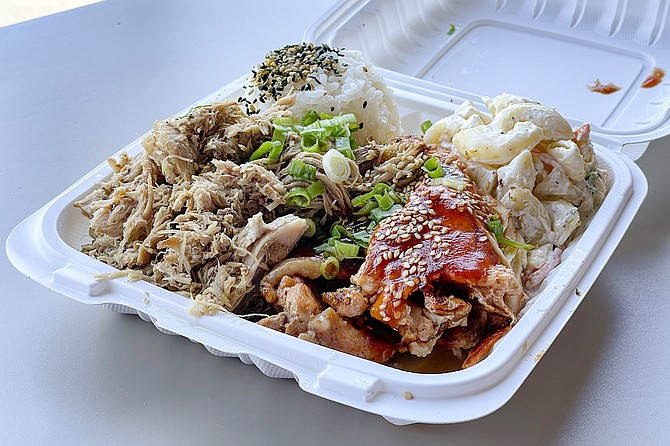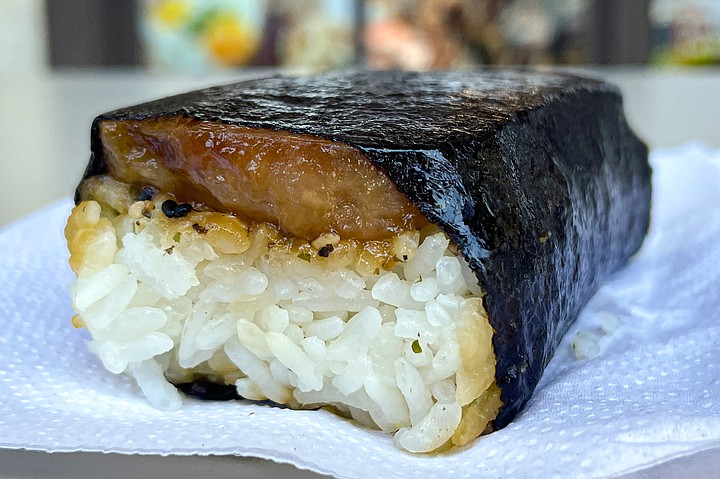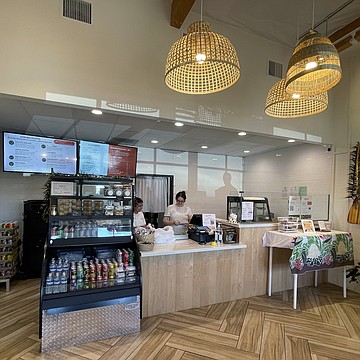 Facebook
Facebook
 X
X
 Instagram
Instagram
 TikTok
TikTok
 Youtube
Youtube

Into Rancho Peñasquitos I drove, for only the second time ever. There might as well be an ocean between us. I was following the trail of a farmers market vendor that has made the move to into its own storefront. Even when it doesn’t involve Hawaiian food, I always find it inspiring to witness these stories of young entrepreneurs that turn limited resources, and lots of moxie, into dreams come true. And if it does happen to involve Hawaiian food, like Kalei's Kitchenette does, I’ll probably drive a little faster.
Sadly, what I didn’t know is that Kalei’s only currently offers the raw fish salad on Saturday. Disappointed, I decided to nibble on a Spam musubi ($4) while I decided on my next move. Not that it could take much time to do either. Musubi’s really just a tasty morsel of spiced ham sushi. And the daily menu sticks to a handful of Hawaiian classics including teriyaki beef, kalua pork, and loco moco, the one where a beef burger patty gets topped with a fried egg (or two) and gravy.

And as at many a Hawaiian joint, these entrees are served plate lunch style. Meaning that, for $13-$15, they’re paired with side dishes, usually macaroni salad and a scoop of rice dusted with the Japanese seaweed and seasoning blend, furikake; though you may swap in pickled cucumbers for either.
I would opt for a Kalei’s Plate ($17), which lets you sample two entrees. This gave me a chance to try the huli huli chicken and kalua pork. I dug first into the mac salad, because I’m a kid at heart, and next into the furikake rice, because I ascribe to the magical thinking that a tiny bit of seaweed will counter the cholesterol of all that mac salad mayo.
Next came the huli huli, a dish so nice they named it twice. Topped with green onions and sesame seeds, it’s otherwise the kamaʻāina answer to the sort of chicken suburban Americans grill every summer on our backyard barbecues. And in that regard, it reminded me of my own, too often landlocked childhood, though maybe a bit better cooked (sorry, Dad). Problem was, mine wasn’t nearly as smoky as I’ve come to expect, which may or may not be a function of Kalei’s moving a long outdoor operation, indoors. This bird wanted more flavor.

On the other hand, the kalua pork quickly became my favorite in greater San Diego. Ironically, it’s because this kalua was a little less flavorful than most, meaning the pulled pork wasn’t super salty. Just a generous portion of savory, succulent meat, an ideal companion for both the mac salad and rice.
On the poultry front, I’ve since been told the garlic chicken is a better move. Which may be true of every garlic chicken in all the cuisines of the world for all I know. My eyes always skip past garlic chicken on a menu, in favor of something like huli huli, which sounds less predictable, and more memorable. Here at least, it’s a garlicky take on fried chicken, which means I now have to drive all the way back to Peñasquitos to try both the poke and Hawaii fried chicken. At least that’s still closer than Lahaina.


Into Rancho Peñasquitos I drove, for only the second time ever. There might as well be an ocean between us. I was following the trail of a farmers market vendor that has made the move to into its own storefront. Even when it doesn’t involve Hawaiian food, I always find it inspiring to witness these stories of young entrepreneurs that turn limited resources, and lots of moxie, into dreams come true. And if it does happen to involve Hawaiian food, like Kalei's Kitchenette does, I’ll probably drive a little faster.
Sadly, what I didn’t know is that Kalei’s only currently offers the raw fish salad on Saturday. Disappointed, I decided to nibble on a Spam musubi ($4) while I decided on my next move. Not that it could take much time to do either. Musubi’s really just a tasty morsel of spiced ham sushi. And the daily menu sticks to a handful of Hawaiian classics including teriyaki beef, kalua pork, and loco moco, the one where a beef burger patty gets topped with a fried egg (or two) and gravy.

And as at many a Hawaiian joint, these entrees are served plate lunch style. Meaning that, for $13-$15, they’re paired with side dishes, usually macaroni salad and a scoop of rice dusted with the Japanese seaweed and seasoning blend, furikake; though you may swap in pickled cucumbers for either.
I would opt for a Kalei’s Plate ($17), which lets you sample two entrees. This gave me a chance to try the huli huli chicken and kalua pork. I dug first into the mac salad, because I’m a kid at heart, and next into the furikake rice, because I ascribe to the magical thinking that a tiny bit of seaweed will counter the cholesterol of all that mac salad mayo.
Next came the huli huli, a dish so nice they named it twice. Topped with green onions and sesame seeds, it’s otherwise the kamaʻāina answer to the sort of chicken suburban Americans grill every summer on our backyard barbecues. And in that regard, it reminded me of my own, too often landlocked childhood, though maybe a bit better cooked (sorry, Dad). Problem was, mine wasn’t nearly as smoky as I’ve come to expect, which may or may not be a function of Kalei’s moving a long outdoor operation, indoors. This bird wanted more flavor.

On the other hand, the kalua pork quickly became my favorite in greater San Diego. Ironically, it’s because this kalua was a little less flavorful than most, meaning the pulled pork wasn’t super salty. Just a generous portion of savory, succulent meat, an ideal companion for both the mac salad and rice.
On the poultry front, I’ve since been told the garlic chicken is a better move. Which may be true of every garlic chicken in all the cuisines of the world for all I know. My eyes always skip past garlic chicken on a menu, in favor of something like huli huli, which sounds less predictable, and more memorable. Here at least, it’s a garlicky take on fried chicken, which means I now have to drive all the way back to Peñasquitos to try both the poke and Hawaii fried chicken. At least that’s still closer than Lahaina.